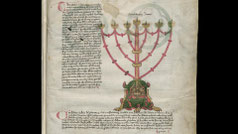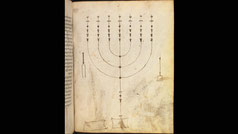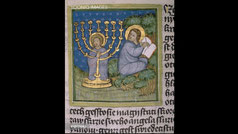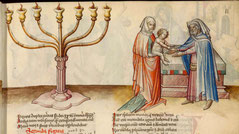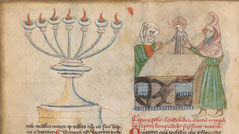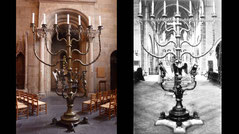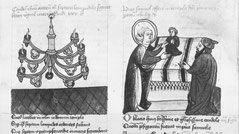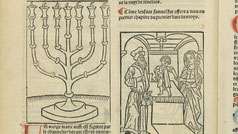ANCIENT AND NEW MENORAHS - 15th Century
This website shows historic menorahs from the fifteenth century. Menorah illustrations from other centuries: Ancient Menorahs until the 1st century, 2nd century, 3rd century, 4th century, 5th century, 6th-10th century, 11th-13th century, 14th century, 16th century, 17th century, 18th century, 19th century, 20th century, 21st century. Coins and Medals

15th century. Speculum humanae salvationis, rhytmice cum figuris pictis (Translated: Mirror of Human Salvation). Handwriting on parchment. Lanuage: Latin. München, Germany. Bayerische Staatsbibliothek, BSB Clm 9716. Source: Link

1400-1450. Speculum humanae salvationis (The Mirror of Human Salvation), translated into Low German. Explanatory notes written in Danish in a 16th-century hand have been added to the text. Origin: Germany. Det Kongelige Bibliotek (Denmark), GKS 80 2º. Source: Link

1400-1500. Speculum humanae salvationis. The seven-branched candlestick menorah (candelabri templi) of the temple and Hannah presents Samuel to Eli in the temple at Shiloh. Place of origin: Germany(?). Material: Paper. ©Koninklijke Bibliotheek National Library of the Netherlands, Signature: The Hague, RMMW, 10 C 23. Source: Link

15th century (early). Title: "Speculum humanae salvationis". Language: German. Dimensions: 37,25 x 29 cm. Second image: Dedication of the young Samuel to the Lord. Bayerische Staatsbibliothek, Signature: BSB-Hss Cgm 3. Source: Link

1400. The Paduan Bible Picture Book. Old Testament Books of Exodus, Leviticus, Numbers, Deuteronomy and Joshua. The layout and style is unique in an Italian manuscript. Origin: Italy, N. (Padua?). Language: Italian. Material: parchment. British Library Add MS 15277. Source: Link

15th century (Early fifteenth century). Speculum humanae salvationis. Seven-armed chandelier (left side) and the boy Samuel is dedicated to the Lord (image on the right side). Region of origin: Cologne (Köln, Germany); involved painter: Hermann Wynrich von Wesel. Material: Parchment, colored line drawing. University of Heidelberg. Biblioteca Apostolica Vaticana, Pal. lat. 413. Source: Link

1401-1500. Title: "Speculum humane salvationis. Johannes Andreae Lectura super quarto libro Decretalium; Lectura super arboribus consanguinitatis et affinitatis." Author: Johannes Andreae (1275?-1348). Latin manuscript. This candlestick has only five arms. Bibliothèque nationale de France, Département des manuscrits, Latin 9586. Gallica. Source: Link

1401-1500. Speculum humane salvationis. Language: Latin. Bibliothèque nationale de France, Département des manuscrits, Latin 9585. Gallica. Source: Link

1401-1500. Speculum humanae salvationis. France. Reliure veau raciné au chiffre de Charles X. Material: Parchment. Bibliothèque nationale de France, Latin 512. Gallica. Source: Link

15th century (2nd quarter of the 15th century). Speculum humanae salvationis. The painter has made a mistake, because the candlestick has only six arms. Second image: Dedication of the young Samuel to the Lord. Origin: Augsburg, Germany. Biblioteca Apostolica Vaticana, Inv.Nr./Signatur: Pal. lat. 1806, fol. 012r. Source: Link1, Link2

15th century. Speculum humanae salvationis. Place of publication can not be determined. Material: paper and parchment. Dimensions: 29,2 x 21,5 cm. Stadtbibliothek Mainz (Germany), Signature: StB Mainz, Hs II 10. Source: Link
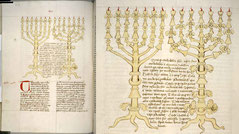
1404. Nicolaus de Lyra: Postilla super Pentateuchum, Iosue, Iudices, Ruth. Folio 105v shows the seven-branched candlestick (candelabrum) menorah, allegorical interpretation. Folio 123r shows the tabernacle. Explanations to their layout, supplement. Codex completed on 2 June 1404 (Finito libro sit laus et gloria Christo, Amen). Manuscripta.at, Austria. Source: Link1, Link2, Link3

1404. Zaragossa (Aragon, Spain) Bible by Hayyim ben Saul Migdoli (Scribe). Menorah, Sanctuary Implements, Carpet page, Full page framed by text, Stepping Stone of the Menorah, Snuffdishes (mahtot), Tongs (melkahayim), Staves. Location: France, Paris, Bibliotheque Nationale (BN), héb. 31. Photograph Copyright: Center for Jewish Art. Source: Link

15th century. Instruments of the Temple with menorah, from the Hebrew Bible. Medium: vellum. Author: Italian School. Ms.OR.26 fol.26r. Description: Diamension: 468x600. Location: Biblioteca Estense Universitaria, Modena, Italy. Source: Link1 Link2 Please see the Modena Catalan Bible from 1370-1400: Link

1410. Commentary on the Torah and the prayers by Menaḥem Reqanati; extracts from the Zohar. Menorah with the text of Psalm 67. Origin: Italy. As early as the 13th century, there were several incidences of copies of the Talmud and Hebrew codices being burned by order of the Pope on the accusation of "blasphemy, error or heresy"; the best-known example is perhaps the burning of 12,000 codices in Paris in 1242. University Hamburg, Signature: Codex hebraicus 53. Source: Link1, Link2, Link3

1410. Speculum humanæ salvationis in Dutch ("Spieghel der menscheliker behoudenisse"). The Speculum is an early 14th century encyclopaedic work on typology, a form of biblical exegesis in which events of the Old Testament are interpreted as prefigurations of those of the New Testament. British Library, Add MS 11575. Source: Link
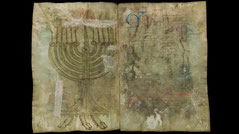
1414-1421. German History Bible (Historienbibel), probably made in Alsace (Elsaß, Germany at that time, now France). Instead of 7, this Menorah has too many lamps, namely 12. Writing material: parchment. Writing space 270 x 190 mm. Dresden, Landesbibliothek Dresden, Shelf mark: Mscr.Dresd.A.49. Source: Link1, Link2

1414-1421. German History Bible (Historienbibel). This menorah does not have 7, but 12 lamps. Size: 40 x 27.4 cm. Writing room: 25.2 x 17 cm, two columns. Place of publication: Hagenau in Alsace? Staats- und Universitäts-Bibliothek Dresden (SLUB), Germany, Shelf mark: Mscr.Dresd.A.50. Source: Link1, Link2

1415-1425. Speculum humanae salvationis. Master of the Brno Speculum (active Netherlands, c1410-1425). Photo: James Marrow. Location: Nová Riše, Kanonie sv. Petra a Pavla → 80, fol. 10r. Source: Link

1418. Speculum humanae salvationis - Pseudo-Bernardus Claraevallensis - Petrus Alfonsi. Material: Paper. Origin: Erfurt (?), Germany. University Wuerzburg, Germany, M.ch.f.2. Source: Link

1420. Biblical History, "Compilatio historiarum totius Bibliae et historiarum scholasticarum." Pen drawing: Candelabrum with seven candles labeled: "candelbrum aureum quod fecit moyses per manum boseleel filii buri de auro purissimo ut patet exodi." Moses, wearing hat, stands behind and holds tables of law inscribed with three commandments. Ark of Covenant as box, surmounted by border of standing trefoils. Austria. Pierpont Morgan Library. MS M.192. Source: Link

1420-1430. German version of the "Speculum humanae salvationis". German title: „Spiegel menschlicher gesuntheit“. It is based on the combination of texts and pictures to illustrate the action of salvation. On a grassy ground stands the seven-armed menorah. The the arms are decorated with blossoms and foliage sits on three curved feet. Middle Rhine area. Parchment, 59 pp., 192 colored pen drawings. Heidelberg University, Cod. Pal. germ. 432. Source: Link1, Link2

1421 (5181). The drawing is from a commentary on the Torah by noted Jewish scholar Shlomo Yitzhaki (Rashi). Title: Pejruš ha-tora (Commentary to the Torah). Repository: Biblioteka Uniwersytecka w Wrocławiu; Wrocław (Breslau), Polska, Poland. Source: Image repository of the National Library of the Czech Republic. Manuscriptorium, Shelf-mark: F 47087 (5). Source: Link1, Link2

15th century. Hamburg stamp (Bibliothek Warburg). Artist: Venetian. London, British Library, Miscellany, Add MS 41600, fol. 83v-84r. Source: Link
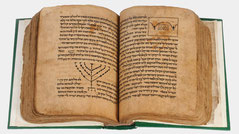
15th century. Ilustrated manuscript Midrash Maor HaAfela, Yemen. Signature of Rabbi Yichye Yitzchak HaLevi Av Beit Din of Yemen. This Talmudic Legend was originally written in Judeo-Arabic and was one of the basic Judaism books in Yemen. The author integrated Kabbalistic and philosophical concepts with commentary. Kedem Auctions. Source: Link1, Link2
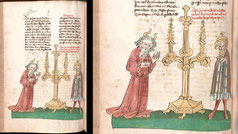
1425. History Bible, the life of Mary. German Title: "Historienbibel, Marienleben." From the workshop of Diebold Lauber in Hagenau (Elsass, Alsace, Germany at that time, now France). While Lauber’s name is first documented in the 1440s, his scribal workshop existed in various forms from circa 1420 to circa 1470, producing numerous manuscripts, of which around 70 have been identified. Bayerische Staatsbibliothek, Shelfmark: BSB Cgm 1101. Source: Link1, Link2

15th century. History Bible from Alsace (Historienbibel, elsässisch). Made in Hagenau, Alsace workshop Diebold Lauber (1427-1471). From the workshop Lauber went out about 80 predominantly illustrated manuscripts, among which in addition to scholarly writings also German-language chronicles and illustrated copies of significant works of medieval literature. Stadtbibliothek Mainz, StB Mainz, Hs II 64. Source: Link
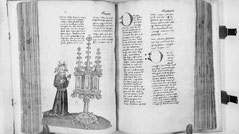
15th century. History Bible (German: Historienbibel) with 112 pen drawings from the workshop of Diebold Lauber (1427-1471) from Hagenau (Alsace, Elsass). Manuscript from the Middle Ages. Writing room: 395 x 260 mm, 325 pages. Köln (Cologne, Germany), Historisches Archiv der Stadt, Best. 7010 (W) 250. Source: Link1, Link2

15th century. Bible by Diebold Lauber (1427-1471). Lauber has published several menorah presentations. He did not know what the biblical menorah really looked like. Bonn, Universitäts- und Landesbibliothek Bonn. © Rheinisches Bildarchiv Köln. Source: Link

1427. Speculum Humanae Salvationis. Language: Latin. Written possibly by Brother Thomas de Austria ordinis sancti Johannis. Using illustrations and texts, the "Speculum humanae salvationis" portrays selected tales of healing from the Old and New Testaments. Richly decorated with pen sketches, this is one of the most beautiful manuscripts held by the monastery of Muri. Sarnen (Switzerland), Benediktiner-Kollegium, Cod. membr. 8. Copyright: Urs Graf Verlag, Dietikon. Link

15th century. Speculum humanae salvationis. Preserves 40 miniatures with Germanic iconography, presents two miniatures per page, heading each column. Drawings in feather, coloured in water, predominantly green, red and brown. They bear an explanatory legend of what they represent: scenes from the Old and New Testaments. Physical description: 10 h. (2 col., 25 lines): il.; perg.; 30 x 23. Madrid, Biblioteca Nacional de España, 8562, fol. 3r. Source: Link1, Link2

1430-1450. Medieval Speculum humanae salvationis. Bible Scenes. Old Testament and New Testament parallels in a copy. Image description: Seven-branched candlestick menorah (catholic symbol of Virgin) and child Samuel presented to the Lord. Place of origin: Catalonia, Roussillon, Spain. Collection: Medieval and Renaissance Manuscripts. Shelfmark: MS. Douce 204, fol. 010v. Source: Link

1430. "The Golden Candlestick which signify Mary" ("Candelabrum cum vij lucernis significat Mariam") in: "Speculum humanae salvationis" (The Mirror of Human Salvation), The origins lie in a Latin work from the beginning of the 14th century (produced in Germany). The text was frequently adapted and translated. Parchment. Origin: Germany. Det Kongelige Bibliotek. GKS 79 2º. Source: Link1, Link2, Link3

15th century. Le Miroir de l'umaine saulvation (The Mirror of the Human Saulvation). Language: French. Fol. 15r. Bibliothèque nationale de France. Département des manuscrits. Français 188. Source: Link

15th century (mid). Speculum humanae salvationis created in Burges, Belgium. Medieval manuscript. Candelabrum (menorah), lighted, with seven arms set on three-footed base (tripod). Language: Latin and Dutch. Artists: Gold Scrolls Group. Pierpont Morgan Library. MS M.385. Source: Link

1430 (ca.). German History Bible. Title: "Deutsche Historienbibel, altes und neues Testament". Made in Hagenau (Alsace, Elsass) by Diebold Lauber (1427-1471). This Menorah not only has a wrong shape, it also has 2 arms too much. Universitäts- und Landesbibliothek Darmstadt: Hs 1. Source: Link

1430. The Alba Bible is a illuminated manuscript translation of the Old Testament made directly from Hebrew into Medieval Castilian. It was carried out under the direction of Moses Arragel, rabbi of the Jewish community of Maqueda in the Spanish province of Toledo. The menorah flames incline inwards, while the central flame is straight and rises between the columns corresponding to the description in the biblical text which stems from ancient rabbinic tradition. Source: Link1, Link2
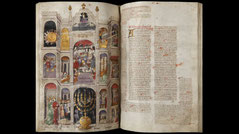
1430. The Alba Bible (Biblia de Alba), first translation into Spanish of the Bible by a Sephardic Jew. The aim of translating from Hebrew into Spanish was to promote understanding and tolerance between Jews and Christians. The Sephardim (according to the Hebrew name for Spain) are the Jews and their descendants who lived on the Iberian peninsula until their expulsion in 1492 and 1513. For centuries thereafter, no open Jewish life was possible in Spain until the modern age. Link1, Link2, Link3,

1430. The Alba Bible (Span. La Biblia de Alba; Biblia de Moses Arrageles). Spanish Bible translates from the Vulgate. From 1492, the year in which the Alhambra Decree issued mandating the expulsion of all Jews from Spain, until 1622, when it resurfaced in the Palace of Liria owned by the House of Alba, the whereabouts of the Alba Bible were unknown. Source: Link1, Link2, Link3, Link4, Link5

1430. The picture shows the Menorah of the Alba Bible. Reprint 1920-1922, Title: "Biblia Traducida del hebreo al castellano por Rabí Mose Arragel de Guadalfajara (1422 1433?) y publicada por el Duque de Berwick y de Alba." Printed in Madrid by Imprenta Artística (page 277, 342 and 908. Biblioteca Digital Hispánica, Signature: r/805. Source: Link1, Link2
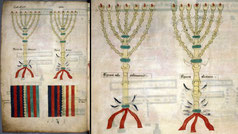
1430-40. Illustrations to Nicholas of Lyra’s Postilla, including the menorah and the High Priest. The Menorah, the golden seven-branched lamp stand with almond blossom decoration, described in Exodus 25. For Jewish and Christian scholars alike, it was important to be able to show that biblical descriptions of the Temple and its furnishings were accurate portrayals. But the text of Exodus was not always clear or easy to follow. Shelfmark: MS. Laud Misc. 156. England. Source: Link1, Link2, Link3

1436. Speculum humanae salvationis. Golden Menorah. Medium: Handwriting; Material: Parchment; Dimensions: 29 x 21 cm. Language: Latin. Localization: France? Flanders? Universitätsbibliothek Leipzig, Cod. Haen. 3506. Source: Link

1436. Speculum humanae salvationis. Languages: Latin and German. Material: Papaer. Origin: Elsass (Germany at that time). Online-Book: Freiburg: Univ.-Bibl. Online-Ressource (Freiburger historische Bestände - digital: Freiburger Handschriften; Hs. 179). Source: Link

1439. Dutch History Bible (Niederländische Historienbibel). Utrecht, Netherlands. This is the illustration of the explanations of the Book of Exodus, but the 7 lamps are not on a chandelier, but hang down from the ceiling. Bayerische Staatsbibliothek, Germany, Shelfmark: BSB Cgm 1102. Source: Link

1440. Manuscript title: Speculum humanae salvationis. Language: German, Alemannic. Very special form of the seven-armed chandelier. Format: 28,5-30 x 20,5 cm. St. Gallen, Kantonsbibliothek, Vadianische Sammlung, VadSlg Ms. 352/1-2. Source: Link

1440. (Medieval) Commentary on Exodus. Image description: Exodus 25: Ark of the Covenant (first photo) and the seven lamps (seven-branched candlesticks, menorah). Type of object: Manuscript. Origin: England. Author: John Capgrave. Language: Latin. Material: paper. Collection: Medieval and Renaissance Manuscripts. Shelfmark: MS. Duke Humfrey b. 1. Source: Link

1440-41. Seven-armed candelabrum menorah by Maso di Bartolomeo (1406-1456), an Italian architect, sculptor, goldsmith and bronze founder. Although this candlestick has 7 arms, it does not conform to the form mentioned in the Bible. Shown during the Menorah exhibition 2017 in Rome. Permanent location: Cathedral of Prato in Italy (La cattedrale di Santo Stefano, Prato). Source: Link1, Link2

15th century (end). Menorah candelabrum in Brno, Cistercian Monastery, St. Mary's Church, transept, southern arm. Apart from the bells, the candleholder is one of the oldest cast works of art in Brno and apart from the fragment of the Milan candlestick is the only one of its kind in the Czech Republic. Brno is the second largest city in the Czech Republic by population and area. "Bazilika Nanebevzetí Panny Marie, Brno." Height: 24.8 cm; Width: 18.5 cm. Link1, Link2, Link3, Link4, Link5

1441. Title: Mazhor, A festival prayer book according to the Italian rite, volume 1. Micrography of a menorah, at Psalm 67. Image taken from f. 18v of Festival prayer book (mahzor), Italian rite, volume 1. Written in Hebrew, Aramaic. Origin: Italy, Central (Florence). Language: Hebrew, Aramaic. British Library, Add MS 19944. Source: Link1, Link2, Link3

1445-1455. Seven-armed chandelier menorah. book illumination, inventory number: at.imareal.005508, place: Austrian National Library, Vienna, Austria. More information: Institut für Realienkunde, Austria. Source: Link

1450-60. Part of: Le Miroire de humaine salvation (Speculum humanae salvationis in the French translation of an unknown person). Material / technique: Opaque paint, gold, parchment. Rheinisches Bildarchiv Köln, Germany. Source: Link

1450-1460. Speculum humanae salvationis. Artist/Creator: Master of Amiens 200 (active c1454-1480). Berlin, Kunstbibliothek → CD 1 R (formerly Lipp. 403), fol. 15r. Source: Link
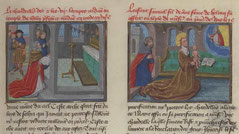
15th century. Miroir de la salvation humaine. Language: French. Translated by Jean Miélot. Parchment, 54 sheets with 2 columns. 415 × 290 mm. Red morocco binding. Bibliothèque nationale de France. Département des manuscrits. Français 6275. Source: Link

1450. The picture shows a candlestick made of gold with 12 (not 7!) candle holders on the edge and a larger one in the middle. German text: "Das im gott hiesz machen ain kertzstul da vil bezaichnung anlagg." The Frauenfelder History Bible was written around 1450 in Diebold Lauber's workshop in Hagenau (Alsace) and reworked a little later. It contains 80 illustrations in which three different hands were involved. Size: 36.4 x 27.2 cm. Frauenfeld, Kantonsbibliothek Thurgau (Switzerland). Source: Link

1450. Speculum Humanae Salvationis. Decoration: 196 coloured pendrawings; penwork initials with pen-flourishes. The seven-branched candlestick menorah and Hannah presents Samuel to Eli in the temple at Shiloh (second image). Place of origin: Cologne (Köln, Germany) by frater Nycolaus (scribe). Language: Latin. Material: Paper. ©Koninklijke Bibliotheek National Library of the Netherlands. Signature: The Hague, RMMW, 10 B 34. Source: Link

1450-1475. Postilla Litteralis by Nicolas de Lyra (1270/75-1349). Place of origin: Hainaut (Belgium), Master of Jacquemart Pilavaine a.o. (illuminators). Exodus: The Ark of the Covenant opened by two cherubim; The veil of the Tabernacle and two seven-branched golden candlesticks (menorahs). ©Koninklijke Bibliotheek National Library of the Netherlands. The Hague, KB, 128 C 8. Source: Link1, Link2

1452. Speculum humanae salvationis. Southern German. Rothenburg ob der Tauber (Lower Franconia), Konsistorial-Bibliothek (kept in the Stadtarchiv) → WD 107, fol. 24r. Source: Link

1454-55. Le Miroir de l'Humaine Salvation. Folio 15 recto. The Presentation. The Ark of the Covenant. The Golden Candlestick. Presentation of Samuel. Author: Conrad de Altzheim and Jehan Mielot. Language: French. Author's preface: Begins - under a picture of the author presenting his work to Philip the Good (Philip le Bon), Duke of Burgundy. University of Glagow, MS Hunter 60 (T.2.18). Source: Link

1454. Commentarii in nonnullos libros veteris testamenti, excerpti ex postilla by Nicolai de Lyra (Nicolaus de Lyra). Bayerische Staatsbibliothek, BSB Clm 14822. Source: Link

1455-1461. Biblia Latina (Bibbia di Borso d'Este). "The Bible of Borso d'Este" [1413-1471; the Duke of Ferrara] is a two volume manuscript. The illuminated miniatures, work of Taddeo Crivelli and others, were executed between 1455 and 1461. The work is held in the Biblioteca Estense di Modena (Ms. Lat. 422-423). The Bible of Borso d'Este, one of the most sophisticated expressions of Renaissasnce miniature work" (Wikipedia). Source: Link1, Link2, Link3

1455-1472. "Postillae super totam Biblam. Tome 2" by Nicolaus de Lyra (author). Latin manuscript. Bibliothèque nationale de France, Département des Manuscrits, Latin 11973. Gallica. Source: Link

15th century (mid). Languages: Latin, French. Bibliothèque municipale, 0183 (Reproduction intégrale). La Bibliothèque Virtuelle des Manuscrits Médiévaux. Souce: Link

1455. Le miroir de humaine saluation. French. Translated from the Latin: Speculum humanae salvationis. The Latin text is usually attributed to Ludolphus de Saxonia. The French translator is not identified. Publisher: Copied and decorated in Flanders. Newberry Collection, VAULT folio Case MS 40. Source: Link

15th century (late). Saint-Omer (Pas de Calais), Speculum humanae salvationis, France, Bibliothèque municipale → 236, fol. 20v. Source: Link

1456. Speculum humane salvationis. Parchment. Size: 70 sheets. Format: 29 × 19 cm. Wolfenbütteler Digitale Bibliothek (WDB, Germany), Cod. Guelf. 81. 15. Aug. fol. Source: Link
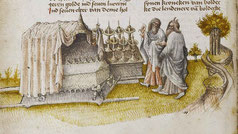
1457. Lower Rhine History Bible, probably from Cologne (?). German Title: Niederrheinische Historienbibel (wahrscheinlich aus Köln?). Here we can not speak of a "Mehorah", because the seven lamps stand individually near the Ark of the Covenant. Staatsbibliothek zu Berlin, Preußischer Kulturbesitz, Germany. Shelfmark: Ms. germ. fol. 516. Source: Link1, Link2

15th century (end or early 16th century). Title: "Heures / Album de miniatures composite" (Hours / Album of composite miniatures). Seven-branched Menorah in the shape of a Tree of Life. ©Institut de recherche et d'histoire des textes - CNRS. Shelfmark: Amiens - BM - ms. 0107, folio 024. Source: Link1, Link2, Link3

15th century. Menorah from Fiuggi or Anticoli (Menorah di Anticoli). Until 1911, the city Fiuggi (80 km east of Rome), originally was called Anticoli di Campagna. Photo on the right: Menorah Award of Anticoli. The trophy consists of a copy of the Menorah of Anticoli, created by the sculptor Luigi Severa on a fifteenth-century stone from the walls of Palazzo Cajetani di Trevi. Source: Link1, Link2

15th century. An Leabhar Breac ("Speckled Book"), now less commonly Leabhar Mór Dúna Doighre (The Great Book of Dun Doighre") or possibly erroneously, Leabhar Breac Mic Aodhagáin ("The Speckled Book of the MacEgans"), is a medieval Irish vellum manuscript containing Middle Irish and Hiberno-Latin writings. There are 2 drawings, a flower-like diagram on p. 121, a menorah with 7 lamps, and a drawing of the Crucifixion on p. 166. RIA MS 23 P 16 or 1230. Source: Link1, Link2, Link3

15th century (middle). Historical, genealogical, theological and poetic texts relating to Ireland. Image description: Drawing of the seven-branched candlestick menorah. The form reminds of the pictures in the catacombs of Monteverde (for example of Gaudentia) of the 3rd century AD. Country or nationality of origin: Irish. Collection: Medieval and Renaissance Manuscripts. Collection: Medieval and Renaissance Manuscripts. Shelfmark: MS. Laud Misc. 610, folio 032v. Source: Link

1460. Mishneh Torah by Maimonides. A later example of a separately standing menorah we find in the illustration to the manuscript of the "Catalan Mishneh Torah" of Rambam (Spain). Completely different form: the stems are straight, they come out of the trunk at an acute angle, A pyramid form. National Library of Jerusalem. Photograh copyright: Center for Jewish Art. Source: Link1, Link2

1461. Speculum humanae salvationis. Chandelier à sept branches (Candlestick with seven branches). The miniatures (on a paper background, often without a frame) are arranged in pairs, captioned in French and in Latin with often reference to the textual source. Origin: Belgium (Mons). © Institut de recherche et d'histoire des textes - CNRS; Shelfmark: Lyon - BM - ms. 0245. Source: Link, Link2, Link3

1463. Commentary on the Old Testament by Nicholas de Lyra (1270/75-1349), a Franciscan teacher, was among the most influential practitioners of Biblical exegesis in the Middle Ages. Medieval manuscript. In lower margin: drawings. Golden table and 'menorah' (golden seven-branched candlestick), kept in the Tabernacle. Shelfmark: MS. Laud Misc. 154. Source: Link

1463. Speculum humanae salvationis. Published in Bavaria, Germany. Second image: Dedication of the young Samuel to the Lord. Language: German. Bayerische Staatsbibliothek, Signature: BSB Cgm 1126. Source: Link

1465-1470. Furtmeyr Bible. Origin: Regensburg, Germany. This magnificent manuscript was carried off in the Swedish invasion of Germany during the 30-Years War (1618-48). The Furtmeyr Bible finally returned to the successor to its original home, the Bavarian State Library, in 1960. Bayerische Staatsbibliothek, BSB-Hss Cgm 8010 a. Source: Link1, Link2

1465-1475. Medieval seven-armed chandelier menorah. The lamps are arranged in a line, which does not correspond to the instructions of Exodus 25. Book illumination, inventory number: at.imareal.006240, place: Austrian National Library, Vienna, Austria. More information: Institut für Realienkunde, Austria. Source: Link

1467. Postillae litterales et morales in testamentum vetus. Moses: Tabernacle, Candlestick, two seven-branched candelabra both with inscription FIGURA CANDELABRI SECUNDUM RABI SALOMON." Scribe: Johannes de Aveloos. Artist: Maitre de la vraie cronicque descoce. Belgium, Bruges. Pierpont Morgan Library. MS M.535; fol. 90r. Source: Link

15th century. Ciboria and seven-branched candelabra, from 15th century manuscript Lyranus in Pentateuchem, from Celestine Abbey of Amiens, France. Shutterstock, ID: 5850777lg. Source: Link

15th century. Two Menorah (seven-pointed candlestick) on a 15th century manuscript. © Giancarlo Costa / Bridgeman Images, image number: GIA5034610. Source: Link
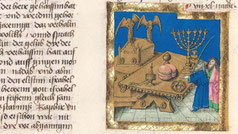
1468-1472. The German "Furtmeyr-Bibel" is one of the most valuable manuscripts in the world. The Regensburg (Germany) Berthold Furtmeyr was one of the last great book painters of the outgoing Middle Ages. The Menorah has the almond blossoms. University Augsburg (Germany) - Oettingen-Wallersteinsche Bibliothek Cod.I.3.2.III. Source: Link1, Link2, Link3

1468. Menorah from the Genealogia Iesu Christi. Origin: South Germany or Austria. Bayerische Staatsbibliothek, BSB Clm 28514. Source: Link

1468-1479. Speculum humanae salvationis (Mirror of human salvation). The candelabrum of the temple of Solomon; image on the right side: The boy Samuel is dedicated to the Lord. Detail (Materials and Techniques): Woodcut illustration. Publishing place: Netherlands. The same image was used in several black/white editions. Source: Link1, Link2, Link3, Link4, Link5, Link6, Link7, Link8

1470-1480. Speculum humanae salvationis (French: "Le Chandelier à sept branches," English: "Mirror of human salvation"). The seven-armed golden candlestick (menorah) in a special and rare shape. Origin: France. ©Institut de recherche et d'histoire des textes - CNRS. Bibliothèque municipale Marseille. Shelfmark: Marseille - BM - ms. 0089. Source: Link1, Link2, Link3, Link4, Link5

1470 (?) Rothschild Miscellany, treasure of the Israel Museum Jerusalem. Origin: Italy. Israel Museum, MS. 180/51. One of the most elegantly executed Hebrew manuscript of the 15th century. It was planned to encompass almost every custom of religious and secular Jewish life. The manuscript comprises 37 religious and secular works incl. Psalms, Job, Siddur, Mahzor, Haggadah... Image (fol. 113v): Al Hanissim 'for the miracles and the redemption'. A man ignites the menorah to Hanukkah. Link1, Link2, Link3, Link4

15th century. Bible moralisée (Moralized Bible). Author: Pol de Limburg (1387?-1416); Jean de Limburg (138x-1416). This Bible is one of 7 moralized Bibles written in Latin, French or both languages, commissioned in medieval times by kings or the court. Liber Genesis - Prophetia Isaiae, chap. XXII, 16. Each excerpt from the scriptural text and the Latin gloss is followed by its translation into French. Bibliothèque nationale de France. Department of Manuscripts. French 166. Link1, Link2, Link3, Link4
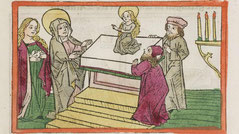
1473. Speculum humanae salvationis cum speculo S. Marie virginis. Text above the image: "Mary the Virgin is sacrificed to the Lord in the Temple" (Original German: Maria die Jungfrau wird geopfert dem Herrn in dem Tempel). Produced in Augsburg (Germany) by St. Ulrich and Afra with Types of Günther Zainer. Staats- und Universitätsbibliothek Hamburg, Signatur: Inc B/14. Source: Link

1473. Speculum humanae salvationis cum speculo S. Marie virginis. Text above the image: "The golden candlestick with the seven lamps means Mary the Virgin" (Original Old German: "Der guldin leüchter mit den syben ampeln bedeuttet Maria die iunckfrauwen"). Produced in Augsburg (Germany) by St. Ulrich and Afra with Types of Günther Zainer. Staats- und Universitätsbibliothek Hamburg, Signatur: Inc B/14. Source: Link
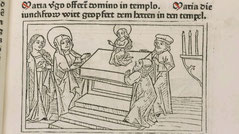
1473. Mary the Virgin is sacrificed to the Lord in the temple. In: Speculum humanae salvationis cum Speculo S. Mariae Virginis. Created in Augsburg (Germany) by Günther Zainer. Rosenwald 48. Source: Link

1473. The golden candlestick with the seven lamps. In: Speculum humanae salvationis cum Speculo S. Mariae Virginis. Created in Augsburg (Germany) by Günther Zainer. Rosenwald 48. Source: Link

1473. Speculum humanae salvationis cum Speculo S. Mariae Virginis. Strange and unique form, chandelier comes from the ceiling of the house. "The Speculum Sanctae Mariae Virginis is intercalated between the chapters of the Speculum humanae salvationis; the latter is accompanied by a German translation and followed by a Latin metrical summary.... Printed in the Abbey of St. Ulrich und Afra" Origin: Augsburg, Germany. Bayerische Staatsbibliothek. Source: Link1, Link2

1476. Speculum humanae salvationis in German. Title: "Hje vahet an ein spiegel menschlicher behaltnuß". Translation of the text above the menorah ("Die ander figur ist der guldin leüchtstock mit den siben ampeln"): "The other figure is the golden candlestick with its seven lamps". Printed in Augsburg (Germany) by Anton Sorg. Bayerische Staatsbibliothek, Signature: 2 Inc.c.a. 531 and BSB-Ink S-510. Source: Link

1476. Title: "Speculum humanae salvationis mit dt. Perikopen und Auszügen aus Der Heiligen Leben." Language: German. Published in Basel (Switzerland) by Bernhard Richel. Bayerische Landesbibliothek, Signature: BSB-Ink S-511 and Rar. 955. Source: Link

1476. "Compilatio historiarum" by Giovanni, da Udine. Bound with: a set of the proof impressions of the woodcuts from "Spiegel der menschlichen Behaeltniss," a Speculum humanae salvationis printed by Bernhart Richel in Basel. First picture: Virgin Mary and Jesus (Baby); below: Ark of Covenant. Top right: Candelabrum, lighted, with seven arms set on base, below: Samuel as child, stands on altar flanked by Eli. German text above the pictures. Pierpont Morgan Library. MS M.158. Source: Link

1476. Title: "Compilatio historiarum" by Giovanni, da Udine. half-page heavily painted drawing of the seven branched candelabrum (menorah) of Moses decorated with foliage. Text is from Genesis. Language: Latin. Origin: Switzerland, Basel. Pierpont Morgan Library. MS M.158. fol. 4r. Dept./Collection: Pierpont Morgan Library Dept. of Medieval and Renaissance Manuscripts. Source: Link

1476. Hebrew Bible with David Kimhi's Sefer Mikhlol ('Kennicott Bible'). The Kennicott Bible is the most exquisite illuminated Hebrew Bible to survive from medieval Spain and combines Islamic, Christian, and popular motifs. Place of origin: La Coruña. Shelfmark: Bodleian Library MS. Kennicott 1. The Bodleian Libraries, The University of Oxford. Source: Link1, Link2, Link3, Link4, Link5

15th-16th century. Title: כונה לאמירת מזמור סז. Kabbalah menorah. Austrian National Library (Österreichische Nationalbibliothek), Vienna, Austria Cod. hebr. 95. National Library of Israel (please see the original link for image in better quality). Source: Link

15th-16th century. Title: PARIS BN 974. The National Library of France, Paris, France Ms. hebr. 974 (Ms. anciens fonds 240). Menorah on Folio 184v. National Library of Israel. Source: Link
![Postilla [litteralis] super totam Bibliam. Nicolaus de Lyra with Menorah](https://image.jimcdn.com/app/cms/image/transf/dimension=238x1024:format=jpg/path/s27429029a488c222/image/i1b65bdef180cf162/version/1527189997/postilla-litteralis-super-totam-bibliam-nicolaus-de-lyra-with-menorah.jpg)
1477. Postilla [litteralis] super totam Bibliam. Nicolaus de Lyra. Made in Strassburg (Germany at that time, now France). Printer: Henricus Ariminensis (Georg
Reyser). Menorah with almond blossoms. The "Postilla
litteralis" is one of the most influential works of biblical exegesis in the Middle Ages and early modern times. It was written between 1322-1330. The name "Postilla" comes from the contraction
of the first two words in the expression "post illa verba sacrae scripturae" (according to the words of the Holy Scriptures). Link1, Link2

1479. Tabernacle from BL Royal 18 D IX, f. 153. Description: Detail of a miniature of men in prayer before the ark and tabernacle. Image taken from f. 153 of La Bible Historiale, Part 1 (Bible Historiale of Edward IV). Written in French. Creator: Guyart des Moulins. Origin: Netherlands (Bruges). The British Library. Source: Link1, Link2, Link3
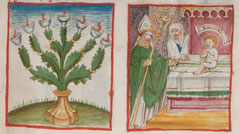
1479? (1459-90). De laudibus sanctae crucis. Speculum humanae salvationis. Place of origin: Elchingen Monastery (Kloster Elchingen, Germany). Language: Latin. Author: Hrabanus <Maurus>. Place: Lorch. Digitale Sammlungen der Württembergischen Landesbibliothek Stuttgart (WLB), Signature: Cod.theol.et.phil.fol.122. Source: Link, Link2, Link3

1479. "Le Mirouer de la redemption de l'umain lignage..." This is the Middle French version of the Latin "Speculum humanae salvationis". Contributor, Translator: Macho, Julien (14..-1477?). Bibliothèque nationale de France, département Philosophie, histoire, sciences de l'homme, Rés. A. 1242. Gallica. Source: Link

1480. Speculum humanae salvationis. Seven-armed menorah with red flames. Language: German. Title: "Das ist der spiegel der menschen behaltnis mit den ewangelien vnd mit epistelen nach der zyt des iars mit dt. Perikopen und Auszügen aus Der Heiligen Leben". Published in Speyer by Peter Drach der Ältere. Bayerische Staatsbibliothek, Germany, Signature: BSB-Ink S-512 - GW M43020. BSB-Katalog -> Rar. 172. Source: Link

1480. Black and white illustration from the above source. The Speculum Humanae Salvationis or Mirror of Human Salvation was a bestselling anonymous illustrated work of popular theology in the late Middle Ages, part of the genre of encyclopedic speculum literature, in this case concentrating on the medieval theory of typology, whereby the events of the Old Testament prefigured, or foretold, the events of the New Testament. Source: Link
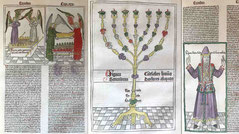
1481. Nicolaus de Lyra (ca. 1270-1349): "Postilla super totam Bibliam." With the Additiones of Paulus de Sancta Maria, bishop of Burgos (ca. 1350-1435) and commentaries of Gulielmus Brito (d. 1356) and of Matthias Döring (d. 1465). Printed in Nuremberg (Nürnberg, Germany) by Anton Koberger, 22 Jan 1481. The illustrations show the system of the cosmos, the plan of the ark, the seven-branched candlestick, the vestments of the priest Aaron, views of the temple etc. Musinsky. Source: Link

1481. Author: Nicolaus de Lyra. Title: Postilla litteralis in vetus et novum testamentum: with Expositiones prologorum by Guilelmus Brito, Additiones ad Postillam Nicolai de Lyra by Paulus Burgensis and Replicae contra Burgensem by Matthias Doering. [1-2 (Genesis - Psalmi; Proverbia - Apocalypsis)]. Published in Nuremberg (Nürnberg, Germany). Bayerische Staatsbibliothek, Shelfmark: BSB-Ink N-114 - GW M26513. Source: Link1, Link2

1483. Title: "Speculum humanae salvationis" in Dutch (mirror of our salvation). Johann Veldener (Culemborg). Bibliothèque nationale de France, département Réserve des livres rares, XYLO-53. Gallica. Source: Link

1483. Title: "Spieghel onser behoudenisse", Dutch version of the "Speculum humanae salvationis". Below the Menorah is this text (translated): "The candlestick of the Temple of Solomon with its lamps." Made in Culemborg by Johann Veldener. Bayerische Staatsbibliothek, Signature: Rar. 713. Source: Link

1483. Nicolaus de Lyra, Guilelmus Brito Exegeta, Paulus Burgensis: "Postilla litteralis in vetus et novum testamentum," with "Expositiones prologorum" by Guilelmus Brito, "Additiones ad Postillam Nicolai de Lyra" by Paulus Burgensis and "Replicae contra Burgensem" by Matthias Doering. Made in Cologne (Köln, Germany). Bayerische Staatsbibliothek Germany, BSB-Ink N-115 - GW M26502. Source: Link

1485. Latin Vulgate Bible. Numerous woodcuts were tinted around the time of its publication. The commentary by Nicolas de Lyra, in a smaller font, is so extensive that it often takes up more space than the Bible text, making for some ingenious type design. University of Dayton Libraries. Source: Link
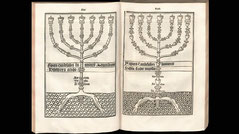
1488. Biblia: with Postilla litteralis by Nicolaus de Lyra, Expositiones prologorum by Guilelmus Brito, Additiones ad Postillam Nicolai de Lyra by Paulus Burgensis and Replicae contra Burgensem by Matthias Doering. - Woodcuts by J. D. Place of publication: Lyon. Language: Latin. Bayerische Staatsbibliothek, Munich (München), Germany, Shelfmark: BSB-Ink B-454 - GW 4290. Source: Link1, Link2
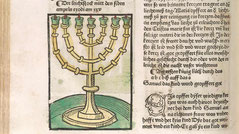
1489. Speculum humanae salvationis. German. menorah image. Title: "Spiegel menschlicher Behaltnuss, mit den Ewangelien vnd Epistelen durch daz gancz Jar". Created in Augsburg by Peter Berger, 6 February (Freitag nach Lichtmess) 1489. Rosenwald 135. Source: Link
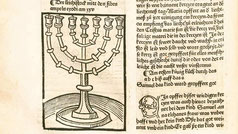
1489. German version of the "Speculum humanae salvationis", Title: "Das ist der spiegel menschlicher behaltnuß mit den Ewangelien vnd Epistelen durch dz gancz Jar: mit dt. Perikopen und Auszügen aus Der Heiligen Leben". Printed in Augsburg by Peter Berger. Bayerische Staatsbibliothek, Signature: BSB-Ink S-513. Source: Link

1489. Biblia with "Postilla litteralis" by Nicolaus de Lyra, "Expositiones prologorum" by Guilelmus Brito, "Additiones ad Postillam Nicolai de Lyra" by Paulus Burgensis and "Replicae contra Burgensem" by Matthias Doering. Publication place: Venice, Italy. Bayerische Staatsbibliothek, Munich, Germany, Shelfmark: BSB-Ink B-463 - GW 4291. Also: Uni Jena. Source: Link1, Link2
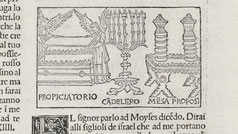
1490. Italian Bible. Italian texts of the Bible were rare before the 15th century. This Bible was translated by Niccolò Malermi (c. 1420-1481), a Camaldolese monk. The printed book includes numerous woodcut illustrations of the narrative, as well as embellished capitals. Creator: Giovanni Ragazzo, for Lucantonio Giunta [printer]. Photo: © Bodleian Libraries, University of Oxford. Polonsky Foundation Digitization Project. Source: Link1, Link2, Link3 (1493)

1490-1494. Title: "Biblia vulgare istoriata." Bible from Niccolo Malermi (Manerbi; 1422-1481). Printed in Venezia, Italy. Language: Italian. Biblioteca nazionale centrale - Firenze - IT-FI0098. Bncf. sbn/CFIE031512. Bayerische Staatsbibliothek Source: Link1 Link2 Link3 Link4 (a similar illustration is in the Latin Biblia sacra from 1551: Link)
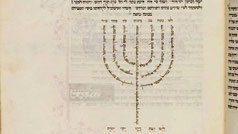
1490. The Rothschild Mazhor (JTS MS 8892; Menorah on page 411r). Florence, Italy. Scribe: Abraham Judah of Camerino. Contains the full order of prayers, for both community and individual, for the entire year. The Library of the Jewish Theological Seminary. Source: Link

1492. Biblia latina with Postilla by Nicolaus de Lyra (1270-1349) and Expositio by Guillelmus Brito in omnes prologos S. Hieronymi and Add. des Paulus Burgensis and Repl. by Matthias Doering. Universitäts- und Landesbibliothek Darmstadt Germany. Source: Link

1492. Speculum humanae salvationis. Footnote: "Spiegel menschlicher behaltnuss" (Mirror of Human Salvation; German: "Heilsspiegel"). Language: German. Origin: Reutlingen, Germany. University Heidelberg, [GW M43019]. Source: Link

1492. Speculum humanae salvationis with pericopes and excerpts from the "life of the saints" ("Der Heiligen Leben"). Language: German. Printed in Augsburg by Johann Schönsperger. Bayerische Staatsbibliothek (Germany), Signature: BSB-Ink S-514 - GW M43008; 2 Inc.c.a. 2768. Source: Link

1500 (2nd March). Speculum humanae salvationis. Language: German. Title: Der spiegel menschlicher bahaltnus mit schenen historien vnd auszüg der Bibel über die ewangelie[n] vndepisteln mit seinen figuren". Printed in Augsburg (Augspurg) by Johann Schönsperger. Wolfenbüttel (Germany): Herzog August Bibliothek, Signature: A: 516.4 Theol. 2°. Source: Link1, Link2

1493-1494. Speculum humanae salvationis (French: Le Mirouer de la redemption de l'umain lignage). Bibliothèque nationale de France, département Réserve des livres rares, VELINS-906. Gallica. Source: Link

1493. Speculum humanae salvationis in Middle French. Title: "Le miroir de la redemption humaine". Printed in Paris by Jean Treperel. Bibliothèque nationale de France, département Réserve des livres rares, RES-A-1247. Gallica. And: Staats-Bibliothek zu Berlin - Preußischer Kulturbesitz, Germany. Source: Link1, Link2, Link3, and BnF RES-A-1247, Gallica (Black-white image): Link

1493. Biblia: With Postilla litteralis by Nicolaus de Lyra, Expositiones prologorum by Guilelmus Brito, Additiones ad Postillam Nicolai de Lyra by Paulus Burgensis and Replicae contra Burgensem by Matthias Doering. Bayerische Staatsbibliothek, Munich, Germany, Shelfmark BSB-Ink B-469 - GW 4293. Source: Link1, Link2, Link3 (1497)

1493. The Schedel's World History (Schedelsche Weltchronik) or Nuremberg Chronicle is an important testimony of German book printing art from the late Middle Ages (1493). It was edited by Hartmann Schedel (1440-1514) and printed on 288 sheets, which corresponds to 576 pages. Latin scholars refer to it as Liber Chronicarum (Book of Chronicles) as this phrase appears in the index introduction of the Latin edition. Wikisource. Source: Link

1493. World Chronicle: colored complete edition by Hartmann Schedel (Author of the text). Figura Ca[n]delabri Lum[in]is. Secundum Doctores aliquos. Printed in Nuremberg (Nürnberg, Germany) by Anton Koberger. Language: German and Latin. © Herzog August Bibliothek Wolfenbüttel. Source: Link1, Link2, Link3, Link4

1493. Liber Chronicarum. An illustrated biblical paraphrase and world history that follows the story of human history related in the Bible. The Schedel world chronicle appeared in a Latin and a German edition. The Latin text was provided by Hartmann Schedel, translated by Georg Altmann into German. Publsher: Anton Koberger, Nuremberg, Germany. To this day, the chronicle is known because of the numerous illustrations, especially because of the often realistic depictions of cities. One of the best-documented incunabulum. Source: Link1, Link2, Link3, Link4, Link5

1493. "Registrum huius operis libri cronicarum cu figuris et ymagibus ab inicio mudi" by Hartmann Schedel, Michael Wolgemut (Illustrator), Wilhelm Pleydenwurff (Illustrator). Printed in Nuremberg (Nuremberge, Nürnberg, Germany). Bayerische Staatsbibliothek, Germany, BSB-Ink S-195 - GW M40784. Source: Link
Similar: Winners Auction Auction No. 113, Lot 38. Source: Link
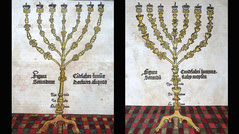
1493. Nuremberg Chronicle of Hartmann Schedel. Coloured original leaf with fullpage woodcut. Printed in the famous printing house of Anton Koberger in Nuremberg, 12th of July 1493. The woodblock cutters were Michael Wolgemuth, the well-known teacher of Albrecht Dürer, his stepson Wilhelm Pleydenwurff and Albrecht Dürer. From the first Latin edition. Ebay. Source: Link1, Link2
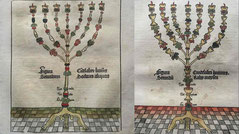
1493. Liber Chronicarum. Edited by the famous humanist and historian Hartmann Schedel. Printed in Nuremberg (Nürnberg, Germany) by Anton Koberger. With over 1800 illustrations by Michael Wolgemut and Wilhelm Pleydenwurff. Language: Latin. Ebay. Source: Link

1493. The Nuremberg Chronicle was originally published in Latin on June 12, 1493. From the outset, however, a German-language version had been planned. Translated by Georg Alt (c. 1450-1510), the city treasurer of Nuremberg, who assisted Schedel in compiling the Latin edition, the German edition was published on December 23, 1493. Approximately 400 Latin copies and 300 German ones survive today. Copyright © 2003 Beloit College. Source: Link1, Link2

1493. Hand-colored woodcut of the menorah from the Nuremberg Cronicle by Hartmann Schedel (1440-1515). Schedel, medical doctor, humanist and historian ist the author of the Cronicle. It was published by Anto Koberger (1440-1513), in Nuremberg, Latin edition in the month of May, the very small and therefore rare German edition in December 1493. Source: Link1, Link2

1493. Cronica Cronicarum ab Initio Mundi by Hartmann Schedel. Text: Latin. There are two illustrations of the chandelier because the scholars disagreed as the Biblical Menorah really looked. But they realized that 22 almond blossoms were spoken. Printed in Nürnberg (Germany) by Anton Koberger for Sebald Schreyer and Sebastian Kammermaister. Univ.-Bib. Frankfurt am Main; Signature: Inc. gr. fol. 18 (Ausst. 170). Source: Link1, Link2, Link3, Link4, Link5, Link6, Link7, Link8, Link9, Link10
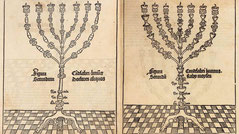
1493. Incunabula page Menorah. Hartman Schedel (not "Shadal"), chronicler of Nuremberg (Nürnberg), Germany. The page is illustrated on both sides with a menorah. Size: 27x39 cm, stains, small tears on the sides, gluing of the paper on the side. LiveAuctioneers 2016, Lot 0087. Source: Link

1493. Nuremberg chronicle (Liber chronicarum) by Hartmann Schedel (Hartmannus Schedel, 1440-1514). Black and white illustration in Google Books and Gallica (BNF). Source: Link1 (German), Link2 (Latin), Link3 (Latin)

1493. The Menorah and a Hebrew Priest, from the Nuremberg Chronicle by Hartmann Schedel (1440-1514) 1493 (colour woodcut). Creator: German School. Medium colour woodcut. Location: Bibliotheque Mazarine, Paris, France, Archives Charmet. Bridgeman Images, image number BMR195595. Source: Link1, Link2, Link3
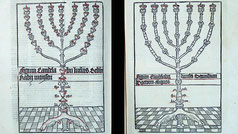
1493. Biblia latina by Nicolaus de Lyra (ca 1270-1349), Guillaume le Breton (1165-1226). Publisher: Anton Koberger (1440-1513) from Norimbergae (Nürnberg, Germany). Source: Link

1494. Viborg cathedral. The seven branched candelabrum of Viborg (Denmark; Danish: Den syvarmede lysestage) was crafted in Lübeck, Germany in 1494 by order of Bishop Niels Globs (-1498). Fully cast in bronze, it stands at a height of approximately 2.7 meters. The foot of the artifact rests on three lying lions, bearing some resemblance to the older candelabrum of Lund. Source: Link1, Link2, Link3, Link4, Link5

1495 (ca.). Speculum humanae salvationis. Language: German (Spiegel menslicher behaltnuss). Images Copyright Biblioteca Apostolica Vaticana. Shelfmark Stamp.Ross.1142. Source: Link

1495. Two different Menorah representations in Latin Biblia with "Glossa ordinaria", "Postilla litteralis" by Nicolaus de Lyra and "Expositiones prologorum" by Guilelmus Brito. Venice: Paganinus de Paganinis. Publication date of the book: 1495.04.18. Bayerische Staatsbibliothek, Munich, Germany, Shelfmark: BSB-Ink B-473 - GW 4283. Source: Link

1496. Liber chronicarum by Hartmann Schedel. German translation from Latin. Printed in Augsburg (Germany) by Johann Schönsperger (1455-1521). Johann Schönsperger also printed a German-language Bible before Martin Luther. E-Rara, Source: Link

1496-1500. Chronica by Hartmann Schedel. Both Menorah pictures show a clear structure with the indicated 22 almond flowers according the Bible (more info). The first menorah was created in the opinion of most scholars. The second illustration corresponds to the idea of Rabbi Moses. This is explained in the German text. Printed in Augsburg by Johann Schönsperger. Universitäts-Bibliothek Frankfurt am Main, Germany, Signature: Inc. qu. 709. Source: Link1, Link2, Link3, Link4, Link5

1498. Biblia, with Glossa ordinaria, Postilla litteralis by Nicolaus de Lyra, Expositiones prologorum by Guilelmus Brito, Additiones ad Postillam Nicolai de Lyra by Paulus Burgensis and Replicae contra Burgensem by Matthias Doering; with details of the individual parts of the Bible in verse, poem to the reader and dedication letter to Johann von Dalberg, Bishop of Worms, Basel 5.9.1498, ed. by Sebastian Brant. P. 1-6, Vol. 1, Basel. Bayerische Staatsbibliothek, Germany, BOD-Ink B-480 - GW 4284. Link
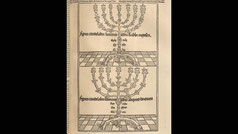
1498-1502. Biblia: Contra perfidiam Judaeorum with Glossa ordinaria, Postilla litteralis by Nicolaus de Lyra (1270-1349), Expositiones by Guilelmus Brito, Additions by Paulus Burgensis (1350-1412) and Replicae by Matthias Doering (1390-1469); with marginal concordances to Gratians Decretum; ed. by Sebastian Brant (1458-1521). Language: Latin. Made in Basel (Switzerland) by Johann Froben for Johann Petri and Johann Amerbach (1498?-1502). Zentralbibliothek Zürich. Source: Link1, Link2, Link3
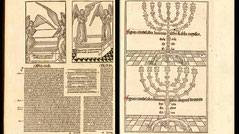
1498. Biblia latina: cum glossa ordinaria Walafridi Strabonis aliorumque, et interlineari Anselmi Laudunensis, et cum postillis ac moralitatibus Nicolai de Lyra, et expositionibus Guillelmi Britonis in omnes prologos S. Hieronymi et additionibus Pauli Burgensis replicisque Matthiae Doering. Universitätsbibliothek Basel, Switzerland. E-RARA. Source: Link

1498. "Cy commence le mirouer de la redemption de lumain", the "Speculum humanae salvationis" translated from Latin in Middle French. Lyon. Contributor, Translator: Macho, Julien (14..-1477?). Bibliothèque nationale de France, département Réserve des livres rares, RES-A-1241. Gallica. Source: Link

Late 15th century. Speculum humanae salvationis. 192 colored pen drawings. Regensburg, St. Emmeram, Benedictine. Bayerische Staatsbibliothek München (Germany), Signature: BSB Clm 14363. Source: Link

15th century. Arbor consanguinitatis et affinitatis; Compendium historiae in genealogia Christi. Petrus Pictaviensis Exposito candelabri. Vatikan, Biblioteca Apostolica Vaticana, Pal. lat. 963. Source: Link
Menorah Pictures from other Centuries:
Until the 1st, 2nd, 3rd, 4th, 5th, 6th-10th, 11th-13th, 14th, 16th, 17th, 18th, 19th, 20th, 21st Century
Note: It's nice to see the menorah pictures. However, according to the Bible Jesus (Yeshua) is the true spiritual meaning behind the physical Menorah. He is the true and eternal spiritual
light: "I am the light of the world. Whoever follows me will never walk in darkness, but will have the light of life" (John 8:12). The menorah also symbolizes the Tree of Life, because
Jesus is the way to life: "I am the way, and the truth, and the life. No one comes to the Father except through me" (John 14:6). Jesus' Word and the Bible are the light in this world. "Your word is a lamp to my feet and a light to my path" (Ps
119:105 and John 1:1-17).
Copyright info and disclaimer: All content and all photos from ancient and new menorahs provided on this website is for informational purposes only. It is not allowed to publish photos from this website on other websites or printed literature. Please always use only the original sources of the photos. We make no representations as to the accuracy or completeness of any information on this website or found by following any link on this website. We will not be liable for any errors or omissions in this information. We will not be liable for any losses, injuries, or damages from the display or use of this information. We can not guarantee the validity and accuracy of the information, please always check the original source. The opinions expressed from other website owners and those providing comments are theirs alone, and do not reflect the opinions of us.
